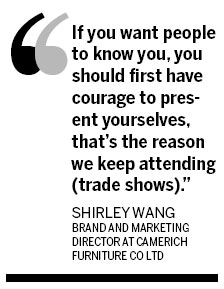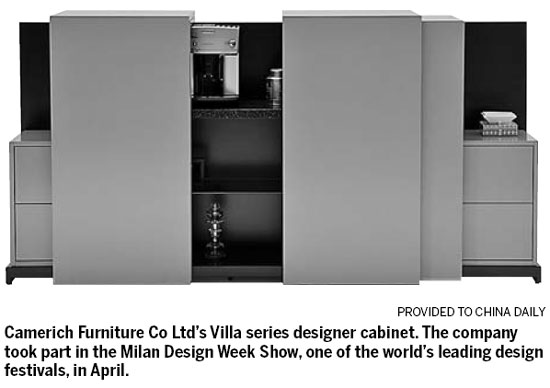
|
The design furniture section at the 17th China International Furniture Expo in Shanghai last September. Provided to China Daily |
Furniture companies seek to build global brands by expanding overseas presence
With nine new stores recently opening overseas, the Chinese furniture company Camerich now has 42 overseas boutiques in including London, Sydney, Seattle, Seoul, Brussels and Singapore.
"Another 10 to 15 are expected to be launched by the end of this year," said Fu Haijun, founder and general manager of Beijing-based Camerich Furniture Co Ltd.
Fu said his company insists on opening specialty stores overseas instead of selling its products in furniture-retailing hypermarkets. The latter is a common practice of furniture brands in Western countries.
"We want our brand to be remembered by clients, and we are devoted to self-designing and building brand loyalty," said the general manager, who has been working in China's furniture industry for 15 years. All of Camerich's design staff are local employees.
Some leading Chinese furniture companies are trying to build a reputation in the international market as designers and manufacturers instead of original equipment manufacturers, said Wang Mingde, an analyst at the domestic brokerage Dongxing Securities Co Ltd.
Different from Camerich, which is determined to expand independently both at home and abroad, Markor Furnishings Co Ltd has chosen to cooperate with international giants to enter foreign markets and comprehensively improve its design capabilities.
The Xinjiang Uygur autonomous region-based company transformed itself from an original equipment manufacturer to a self-branded furniture producer in 2001.
So far, Markor has more than 70 branded stores in 34 cities around China. The number is expected to reach 100 by 2013, according to Liu Chunjie, the company's brand and public relations director.
Also in 2001, Markor set up a cooperative arrangement with the US-based furniture designer, maker and retailer Ethan Allen Group Inc and is promoting its international business through Ethan Allen's 280 design centers and sales networks.
In 2009, it acquired global furniture giant Schnadig International Corp for $8.94 million, and introduced the US company's high-end sub-brand Caracole into the Chinese market last year.
According to the furniture manufacturer's financial report, Markor's sales reached 1.36 billion yuan ($216 million) in 2011, a year-on-year gain of 26.16 percent. Domestic buyers accounted for 54 percent of those sales.
Design concepts

Camerich highlights a modern and simple lifestyle, while combining traditional Chinese characteristics with new Western technologies in terms of materials, fabrics and manufacturing.
"We are sticking to our principle of enabling consumers' individualized choices while continuing to focus on practical use and functionality," said Fu.
The company has been active in designing concept displays. It took part in the Milan Design Week Show, one of the world's leading design festivals, in April to present the Village Mountains design, which had the look of a tall, white, unadorned honeycomb structure. It also held a global concept show at the 17th China International Furniture Expo in Shanghai last September.
At an international furniture exhibition in Guangzhou in March, Camerich released its improved display design.
"If you want people to know you, you should first have courage to present yourselves, that's the reason we keep attending these events," said Shirley Wang, Camerich's brand and marketing director.
As general manager, Fu said his role is putting all of his energy into design and research and development work.
"I love furnishing design and furnishing design should be humanistic," he said.
"Our first goal is to create comfort and enjoyment at home instead of just pursuing a visual sense of beauty. And a combination of tradition and modern technology helps us to achieve that goal."
Camerich's Ming series of chairs were cited as an example.
Based on the style of the Ming Dynasty (1366-1644), but with some modern and abstract characteristics, the materials used include high-tech metal and newly developed environmentally friendly fabrics.
The new man-made fabric, micro-fiber leather, looks and feels similar to genuine leather, while it has the advantages of being heat and cold resistant.
"It caters for consumers at home and abroad with ever-increasing green consciousness," said Fu.
He also attaches great importance to detail. There are no right angles on any of Camerich's tables, due to safety concerns. And its cabinets can be moved easily and assembled in various ways.
The company now provides more than 100 types of products for living rooms, bedrooms, study and dining rooms. Its design team launches new products for every season based on the latest trends and demand.
Over the past five years, Camerich's sales revenue has increased 30 percent annually, with the overseas market's contribution ranging from 40 to 60 percent every year.
Somewhat different from Camerich's focused strategy, Markor diversified its design portfolio to appeal to different sections of the market.
Alongside its flagship brand Markor, it offers Ethan Allen for the global market, Caracole for luxury housing and MHF Home Style for ordinary families' interior decoration needs.
Markor has also strengthened its design capabilities and increased its sales through different kinds of cooperation.
In addition to its internal design team, the company has more than 1,000 contracted designers, including foreign employees, who can commercialize their ideas or designs with Markor's support.
"Such a model is very flexible," said Liu, adding that the company also cooperates with property developers to present its design capabilities.
It joined forces with Guangzhou R&F Properties Corp to launch a housing project in Sanya, Hainan province, with Markor offering interior decoration and home improvement services.
So far, Markor has similar cooperation with a series of domestic developers, such as Hainan Airlines Real Estate Co Ltd and CITIC Real Estate Co Ltd.
Madge Megliola, a contracted designer of Markor and the owner of an independent interior design studio in the United States, said that the differences between consumers in China and the US were "fewer and fewer", so China-designed furniture products are also popular in the US.
"People nowadays are pursuing unique and individuality. Chinese-style designs are attractive to some Americans because they are different from local designs," she said.
Challenges
Although the outlook for China's furnishing industry seems optimistic, analysts said the nation's furniture makers face great challenges, especially in the international market.
China has more than 50,000 furniture companies, most of which are small enterprises, according to the China National Furniture Association. Some brands, such as Camerich, Markor, Qumei and Baiqiang, are competitive in terms of price.
"Their target groups are middle-class and rich households, but due to current house purchase limits in Chinese cities, the furnishing purchasing power of this group is declining," said Wang from Oriental Securities.
liujie@chinadaily.com.cn

(China Daily 08/23/2012 page17)







